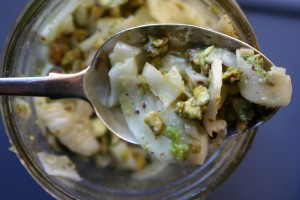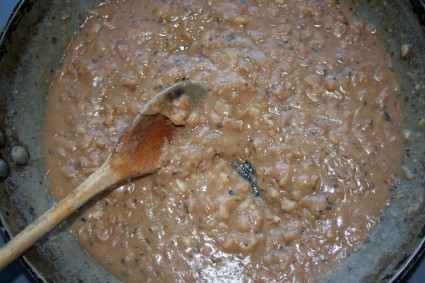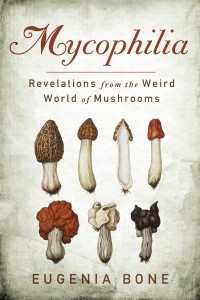Fennel Pistachio Compote
There are three kinds of fennel, bitter, sweet, and Florence. Bitter and sweet fennel have long histories—the seeds and stem of bitter fennel was used to flavor foods in the classical era, and maybe earlier. Sweet fennel has a slight anise flavor, but it is Florence fennel, or finocchio, the one with the big bulb, that really packs that licorice punch.
You can get finocchio year round these days, but traditionally, its season is wintertime. I grew up eating it in salads, roasted with parmesan cheese sprinkled over, and braised in chicken stock. Look for bulbs that are very hard and white, with their feathery greens attached. The greens add great flavor to chicken and fish stocks.
Last year I pickled fennel and it was delicious—I used it a variety of ways. One was as a salad on top of mortadella salami, garnished with pistachio nuts. I was thinking about that garnish and figured it would be tasty to have on hand a finocchio and pistachio compote in oil to hold in the fridge.
I tried it and it turns out to be one of those addicting combinations. I’ve eaten, like, a quarter cup just out of the pint jar with my fingers, shaking off the oil before dropping a pinch in my mouth. But I am going to stop because next time I’ll test it with a very beautiful piece of stripped bass a Montauk fisherman friend gave us, in an egg salad, and I have a slightly weird pasta idea…but first, the compote.
Fennel Pistachio Compote
Makes 1 pint
I like to keep the ingredients chunky for this recipe. If I want to use the compote less as a salad and more as a sauce, I can always grind it up later. The compote is covered with oil, which is only a prophylactic to keep new spoilers out of the jar. But inevitably, there are yeasts and mold spores floating around and they are going to be on these raw ingredients. Eventually, the compote will ferment. It won’t freeze, and it won’t can. So make it, refrigerate it, but try to use it within 10 days (that will be easy when you taste it).
½ lb fennel (about ½ of a large bulb)
½ cup plain pistachios
½ cup olive oil (plus more to cover)
Juice from 1 lemon
1 teaspoon minced garlic
½ teaspoon salt
Freshly ground black pepper to taste
What you need to make the compote
Core and thinly slice the fennel, then chop into pieces about ½ inch long. Place the pistachios in a food processor and pulse to chop, or chop with a knife. You don’t want pistachio powder, just crushed nuts. Combine the fennel, pistachios, and remaining ingredients in a bowl.
Sterilize a pint jar, band, and lid (it’s okay to use a used lid) by boiling in water for 10 minutes (add 1 minute for every 1,000 feet above sea level). Pack in the compote and cover with oil. You could fully saturate with oil. That would be best and give your product the longest life because less air pockets mean less spaces for yeasts and so on to grow. But spoilers will grow, eventually, in the dish like this, so I think it is best not to create a totally oily compote, and just eat it a bit sooner.
Refrigerate for up to ten days. Next time, recipes for using the compote.
The Mycophilia book giveaway is over. Congratulations in advance to all you winners! I hope you like the book. I’ve put up a website with links to some of the scientists and their papers I cite, my mushroom recipes, and all the mycological clubs in the USA, as well as retail links and a calendar of mushroom forays and festivals events (although that’s still evolving…not every festival has a long lead-time web presence). Check it out!



 Subscribe
Subscribe


















